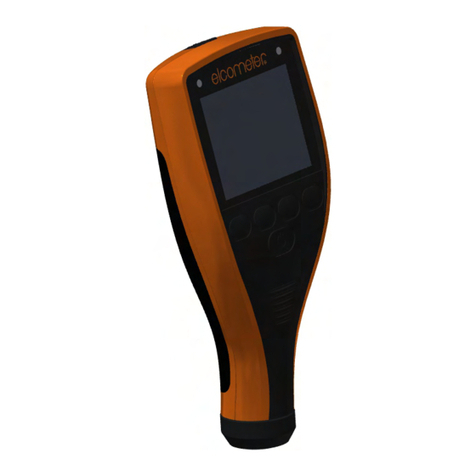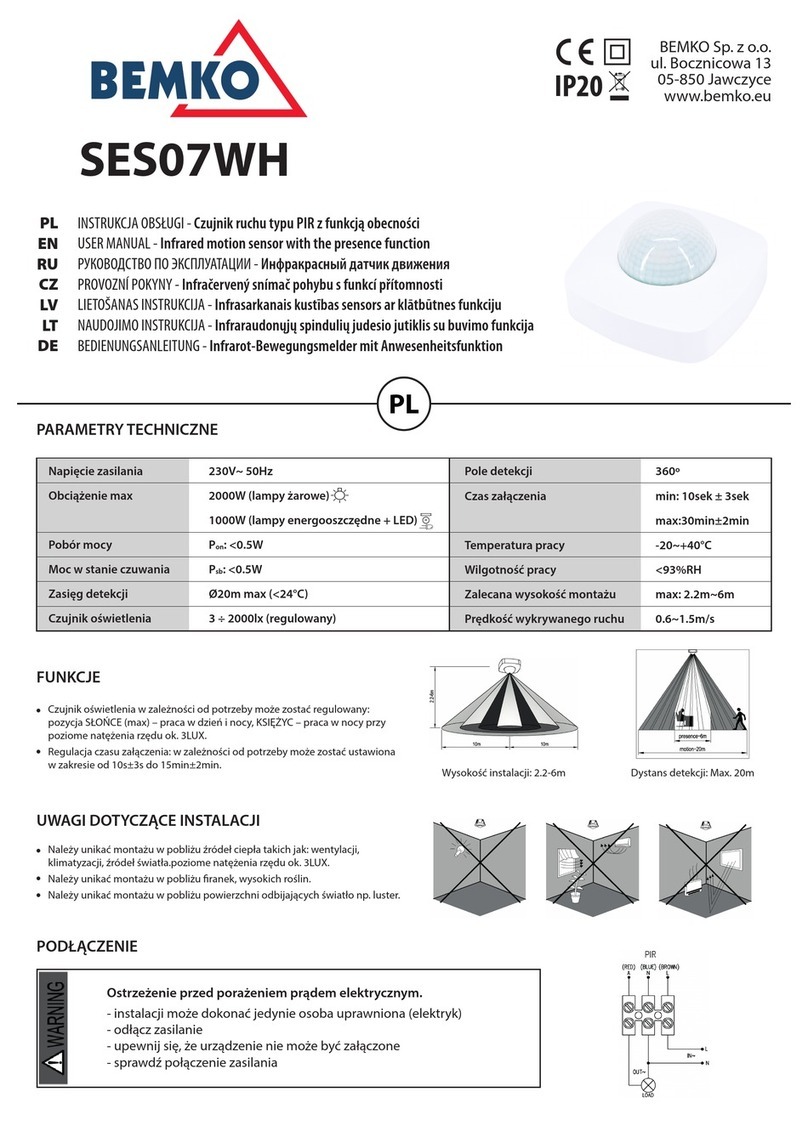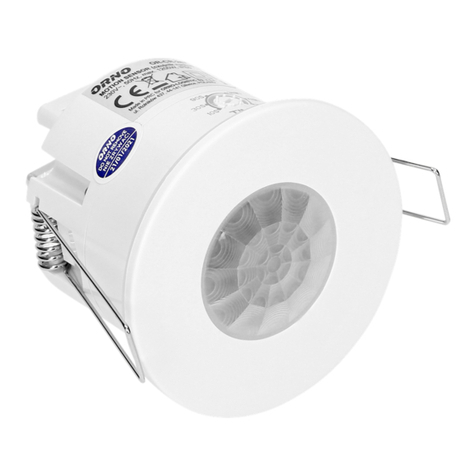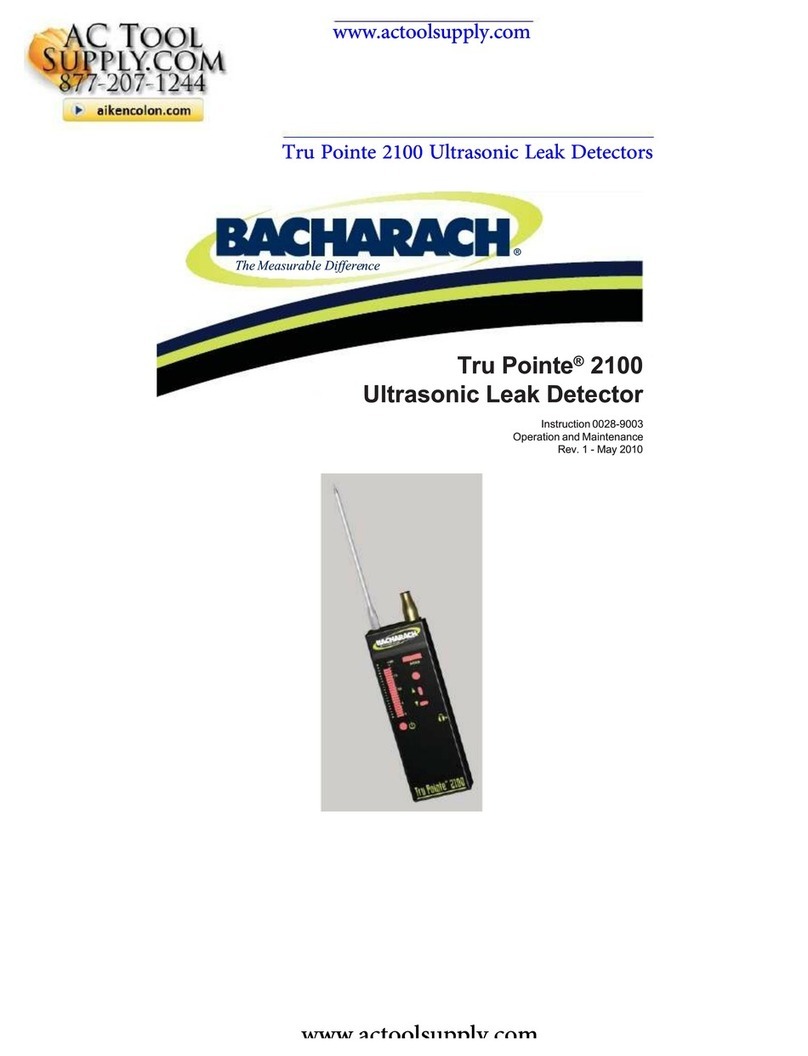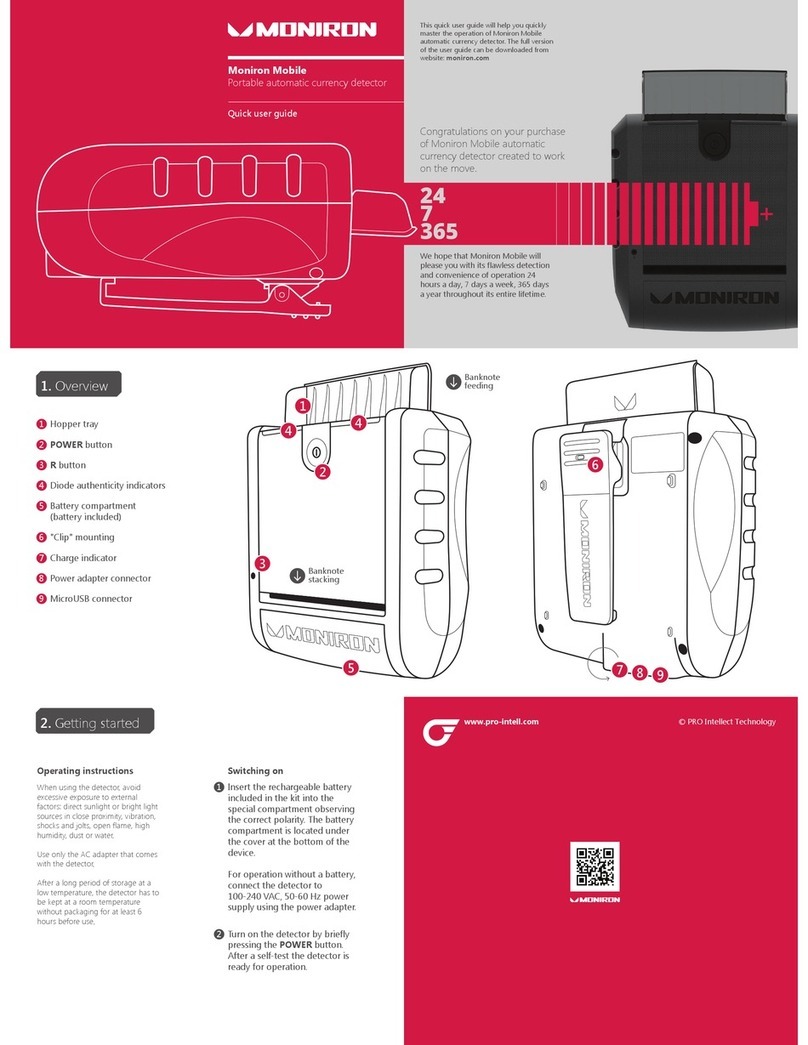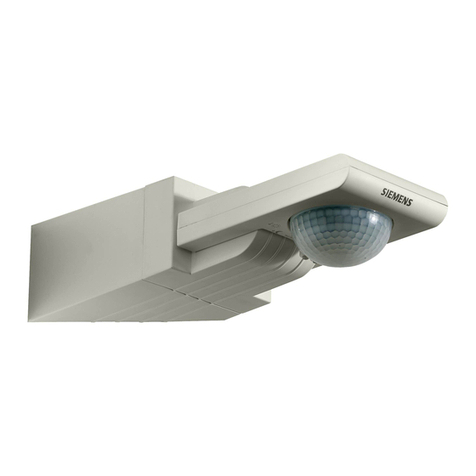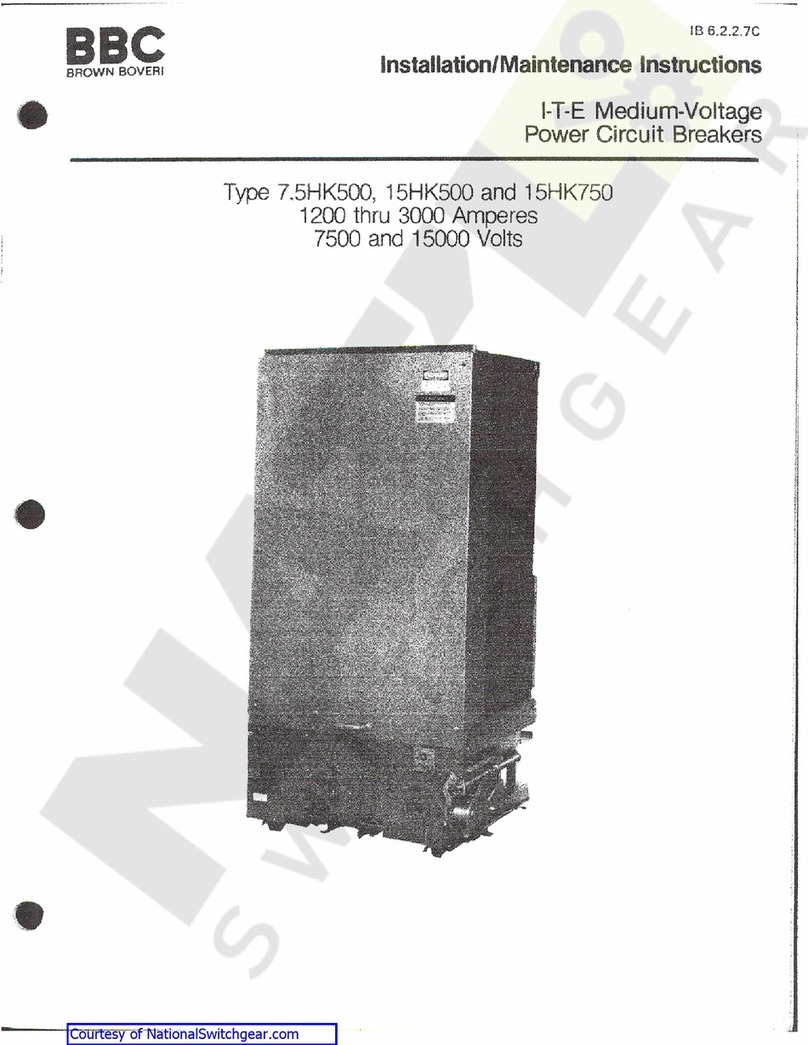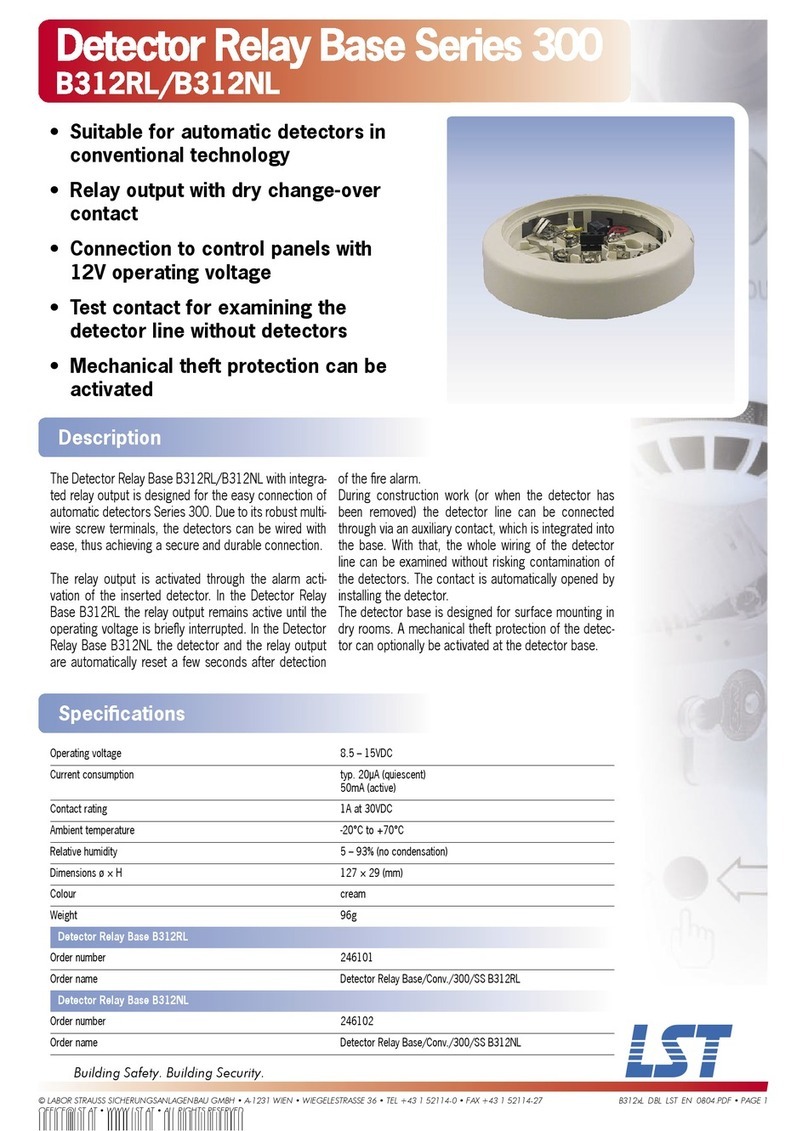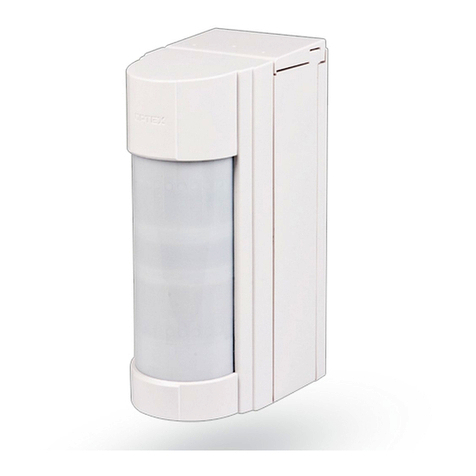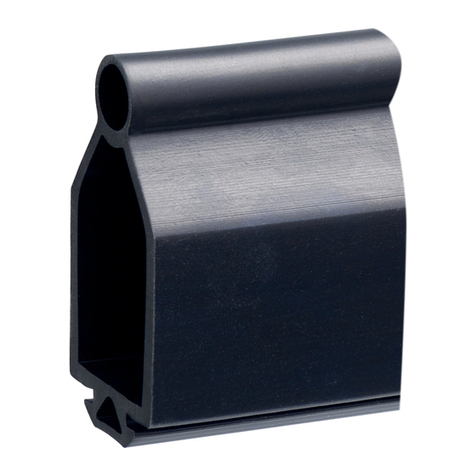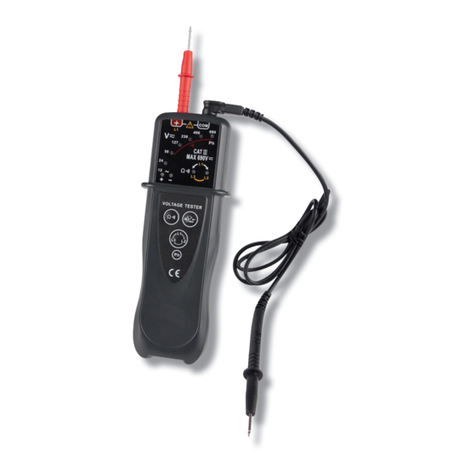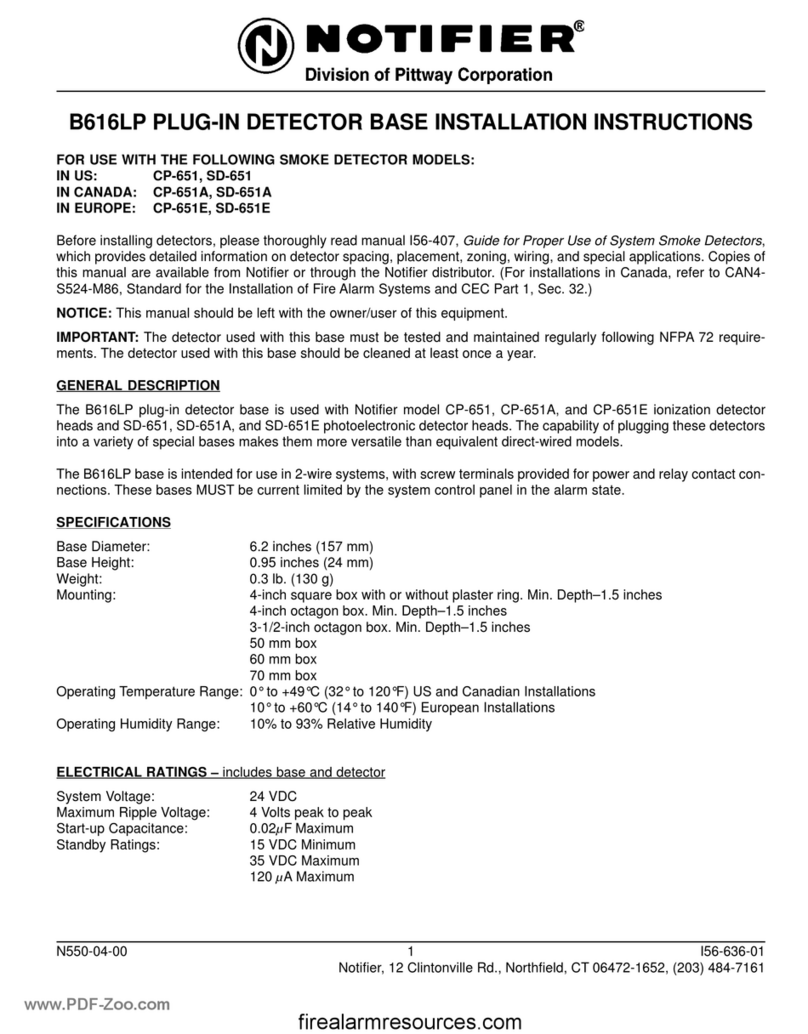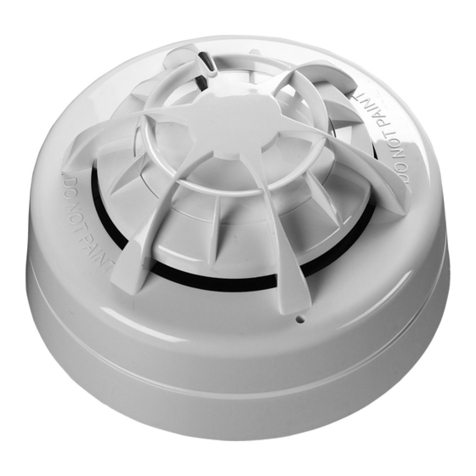Greifzug blocstop BSO Series Instruction Manual

blocstop™ BSO
Fall arrest device for suspended material-lifting and rigging installations
Fangvorrichtung für hochziehbare Personen- und Materialaufnahmemittel (PAM & MAM)
Dispositif antichute pour plateformes suspendues pour levage de personnens et matériel (PSLP & PSLM)
Opvangvoorziening voor omhoog trekbare personen- en materiaalhefmiddelen (PAM & MAM)
00327/0
OUVRIR
OPEN
AUF
ZU
CLOSE
FERMER
OUVRIR
OPEN
AUF
ZU
CLOSE
FERMER
OUVRIR
OPEN
AUF
ZU
CLOSE
FERMER
ZU
CLOSE
FERMER
Model series / Typenreihe /
Série / Serie
blocstop™ BSO 500
Model series /
Typenreihe /
Série / Serie
blocstop™ BSO 1000
Model series / Typenreihe / Série / Serie
blocstop™ BSO 2050/2360
Original Operation and
Installation Manual
Manuel d´installation et de
manutention original
Original-Montage- und
Betriebsanleitung
Originele montage- en
bedieningshandleiding

blocstop™ BSO
EN-DE-FR-NL-II G905.5 - 02/2011
Technical Data / Technische Daten / Données techniques / Technische gegevens
Type3) 4) 5)
Typ3) 4) 5)
Type3) 4) 5)
Type3) 4) 5)
Capacity in t
Tragfähigkeit in t
Capacité in t
Draagvermogen in t
Wire rope specification
Seilspezifikation
Spécification du câble
Kabelspecificatie
Bolt-Ø in mm2)
Bolzen-Ø in mm2)
Diamètre des axes2)
Bout-Ø in mm2)
Persons
Personen
Personnes
Personen
Material
Material
Materiel
Materiaal
Ø in mm
Ø in mm
Ø du câble en mm
Ø in mm
Minimum tensile strength in kN
Mindestbruchkraft in kN
Force minimal de rupture en kN
Minimum breukkracht in kN
BSO 510 — 0,35 6 13,71b)
BSO 500 0,5 0,5 8 39,21a)
BSO 520 0,5 0,5 9 39,21a)
BSO 1000 0,5 0,5 8 39,21a)
BSO 1020 0,8 0,8 9 62,81a)
BSO 1030 1,0 1,0 10 78,51a)
BSO 1040 1,0 1,0 11,5 78,51a)
12
BSO 2050 2,0 2,6 14 157,01a)
BSO 2360 2,3 3,0 16 180,51a)
22
Table/Tabelle/Tableau/Tabel 1
1) Calculation of the required minimum breaking load Foof the rope (does not correspond to the actual, manufacturer-specific minimum breaking load!)
Fo = Zp x S
a) Fo = 8 x S [kg] x 9,81 [N/mm²]
b) Fo = 4 x S [kg] x 9,81 [N/mm²]
Fo: smallest guaranteed breaking load of the wire rope
Zp: = 8 (4): Expansion coefficient of the wire rope
S: maximum static load on the wire rope (maximum working load of the hoist)
2) Strength of the bolt material: 800 N/mm2≅800 MPa. Do not use high-strength galvanised screws (10.9 or 12.9).
3) For hoists with a speed of up to 18 m/min
4) optionally with limit switch: Identification E (e. g. BSO 500 E)
5) Temperature range: -25 – +70 °C, depending on the ambient conditions (ambient temperature, sunrays, etc.) as well as the possible thermal discharge (dirt,
accumulated heat, etc.) / relative humidity < 75 %
1) Berechnung der erforderlichen Mindestbruchkraft Fodes Seiles (entspricht nicht der tatsächlichen, herstellerspezifischen Mindestbruchkraft!)
F
o= Zpx S
a) Fo = 8 x S [kg] x 9,81 [N/mm²]
b) Fo = 4 x S [kg] x 9,81 [N/mm²]
Fo: kleinste garantierte Bruchlast des Drahtseils
Zp: = 8 (4): Ausnutzungskoeffizient des Drahtseils
S: maximale statische Zuglast im Drahtseil (maximale Betriebslast der Winde)
2) Festigkeit des Bolzenwerkstoffes: 800 N/mm2≅800 MPa. Keine hochfesten verzinkten Schrauben (10.9 oder 12.9) verwenden.
3) Für Winden mit Geschwindigkeit bis 18 m/min
4) optional mit Endschalter: Kennzeichnung E (z. B. BSO 500 E)
5) Temperaturbereich: -25 – +70 °C, abhängig von den Umgebungsbedingungen (Umgebungstemperatur, Sonneneinstrahlung, etc.) sowie der möglichen
Wärmeabfuhr (Schmutz, Stauwärme, etc.) / rel. Luftfeuchtigkeit < 75 %
1) Calcul de l’effort de rupture mininal requis Fodu câble (ne correspond pas à l’effort de rupture minimal effectif et spécifique du fabricant!) :
F
o= Zpx S
a) Fo = 8 x S [kg] x 9,81 [N/mm²]
b) Fo = 4 x S [kg] x 9,81 [N/mm²]
Fo: Charge de rupture minimale garantie du câble métallique
Zp: = 8 (4): Coefficient d’utilisation du câble métallique
S: Charge statique maximale du câble métallique (capacité de charge maximale de
fonctionnement du treuil)
2) Résistance du matériau de boulon : 800 N/mm2≅800 MPa. Ne pas utiliser de boulons galvanisés haute résistance (10.9 ou 12.9).

blocstop™ BSO
G905.5 - 02/2011 EN-DE-FR-NL-III
3) Pour les treuils d'une vitesse jusqu'à 18 m/min
4) en option avec fins de course : Marquage E (par exemple BSO 500 E)
5) Plage de température: -25 – +70 °C, en fonction des conditions ambiantes (température ambiante, exposition à la lumière du soleil, etc.) et de l'évacuation de la
chaleur possible sur le site (saleté, accumulation de chaleur, etc.) / Humidité relative de l'air < 75
1) Berekening van de minimum breukkracht Fovan de kabel (komt niet overeen met de daadwerkelijke fabrikantspecifieke min. breukkracht!)
F
o= Zpx S
a) Fo = 8 x S [kg] x 9,81 [N/mm²]
b) Fo = 4 x S [kg] x 9,81 [N/mm²]
Fo: kleinste gegarandeerde breuklast van de draadkabel
Zp: = 8 (4): Belastingscoëfficiënt van de draadkabel
S: maximale statische treklast in draadkabel (maximale bedrijfslast van de lier)
2) Sterkte van het boutenmateriaal: 800 N/mm2≅800 MPa. Gebruik geen extra sterke verzinkte bouten (10.9 of 12.9).
3) Voor lieren met een snelheid tot 18 m/min
4) optioneel met eindschakelaar: Markering E (bijv. BSO 500 E)
5) Temperatuurbereik: -25 – +70 °C, afhankelijk van de omgevingsfactoren (omgevingstemperatuur, zonnestraling etc.) en van de mogelijke warmteafvoer (vuil,
warmtestuwing etc.). / rel. luchtvochtigheid < 75 %
Components / Bestandteile / Composants / Bestanddelen
OUVRIR
OPEN
AUF
ZU
CLOSE
FERMER
ZU
CLOSE
FERMER
BSO 2050–2360
BSO 500–520
BSO 1000–1040
00322/0
OUVRIR
OPEN
AUF
ZU
CLOSE
FERMER
Fig./Abb./Fig./Afb. 1
00323/0
1
6
4
3
5
7
2
Fig./Abb./Fig./Afb. 2

blocstop™ BSO
EN-DE-FR-NL-IV G905.5 - 02/2011
00324/0
e
Ø h
bc
1
g
a
c
2
d
1
d
2
f
a
ef
g
Ø h
bc
1
c
2
c
3
d
1
d
2
a
1
Fig./Abb./Fig./Afb. 3
Measure in mm / Maß in mm / Mesure en mm / Maat in mm
a a1b c1c2c3d1d2e f g Ø h
BSO 500/510/520 214 — 121 131 40 — 64 20 40 12,5 21,5 12,2
BSO 1000/1020/1030/1040 251 — 140 131 40 — 65 20 56 12,5 21,5 12,2
BSO 2050/2360 409 70 150 183 110 55 60 27,5 35 60 36 22,2
Table/Tabelle/Tableau/Tabel 2

blocstop™ BSO
G905.5 - 02/2011 EN-DE-FR-NL-
V
00325/1
blocstop TM
Fangvorrichtung
Fall arrest device
Typ(e): BSO
kg
kg
Original Tractel -
®
Se
il/
rope Ø:
mm
Fabr.Nr./Serial No
Bauj./Year of man
201
Bei Rückfragen/Ersatzteilbestellungen
bitte Typ und Fabr.Nr. angeben!
In case of queries / spare part orders
please mention type and serial number!
Scheidtbachstraße 19-21
D-51469 Bergisch Gladbach
S248.1 12/09 102090
2
1
OUVRIR
OPEN
AUF
ZU
CLOSE
FERMER
ZU
CLOSE
FERMER
Fig./Abb./Fig./Afb. 4
Fig./Abb./Fig./Afb. 5
00328/0
Fig./Abb./Fig./Afb. 6
Fig./Abb./Fig./Afb. 7
Fig./Abb./Fig./Afb. 8
Fig./Abb./Fig./Afb. 9

blocstop™ BSO
EN-DE-FR-NL-VI G905.5 - 02/2011
00302/0
3
1
2
ZU
CLOSE
FERMER
ZU
CLOSE
FERMER
OUVRIR
OPEN
AUF
Fig./Abb./Fig./Afb. 10
Fig./Abb./Fig./Afb. 11
Fig./Abb./Fig./Afb. 12

Installation and operating manual
G905.5 - 02/2011 EN-1
Contents
1General ............................................................................... 2
1.1 Terms and abbreviations used in this manual .......... 2
1.2 Symbols used in this manual .................................... 3
2Safety.................................................................................. 3
2.1 General safety instructions ....................................... 3
2.2 Instructions for the operator...................................... 4
2.3 System manufacturer's responsibilities..................... 4
3Overview............................................................................. 5
3.1 Delivery state ............................................................ 5
3.2 Scope of delivery ...................................................... 5
3.3 Equipment description .............................................. 5
4Description......................................................................... 6
4.1 Functional description............................................... 6
4.2 Components / Modules............................................. 7
4.3 Technical Specifications ........................................... 7
4.4 Operating fluids......................................................... 7
4.5 Circuit diagram.......................................................... 7
4.6 Safety equipment...................................................... 7
4.7 Anchoring.................................................................. 7
5Ropes.................................................................................. 8
6Optional accessories......................................................... 8
7Options ............................................................................... 8
8Model versions................................................................... 8
9Necessary accessories ..................................................... 8
10 Installation and commissioning....................................... 8
10.1 Directives and standards .......................................... 8
10.2 Checks to be undertaken before starting
installation................................................................. 8
10.3 Assembly .................................................................. 9
10.4 Commissioning ....................................................... 10
11 Operating / Operation...................................................... 11
11.1 Checks to be carried out before starting work ........ 11
11.2 Operation with personnel lifting equipment............. 11
11.3 Operation with material lifting equipment................ 12
11.4 Manual EMERGENCY-STOP................................. 12
11.5 Securing the load.................................................... 12
12 Immediate measures to be taken after an emergency-
stop ................................................................................... 12
12.1 Emergency-stops for personnel lifting equipment... 12
12.2 Emergency-stops for material lifting equipment...... 13
12.3 Measures to be taken after a problem or an
emergency-stop ...................................................... 13
13 Foreseeable misuse.........................................................14
14 Dismantling.......................................................................14
15 Transport and storage .....................................................14
15.1 Transport .................................................................14
15.2 Storage....................................................................15
16 Maintenance work ............................................................15
16.1 Authorized maintenance personnel .........................15
16.2 Mandatory inspections.............................................15
16.3 Care and maintenance ............................................15
16.4 Ordering spare parts................................................16
17 Disposal and environmental protection.........................16
18 Troubleshooting...............................................................17
19 EU Declaration of Conformity (Extract)..........................18
19.1 Independent secondary brake for
transport of persons.................................................18
19.2 Independent secondary brake for
transport of materials...............................................20
DANGER!
Risk of injury caused by falling objects, malfunctions,
incorrect usage and incorrect operation!
Failure to follow these instructions:
can result in severe injuries or death,
can result in damage to the equipment.
–Read through this operating manual carefully before you
install and commission this machine.
–Follow the instructions and procedures specified in this
manual in order to ensure safe operation of the equip-
ment.

Installation and operating manual
EN-2 G905.5 - 02/2011
1General
Date of issue
02/2011
Copyright
The copyright of this instruction manual remains with Greifzug
Hebezeugbau GmbH.
This instruction manual is intended only for the operators of the
systems described here and their staff. This instruction manual
must be available to the operating personnel at all times. Addi-
tional copies can be obtained on request.
No part of this instruction manual may be reproduced, distributed
or otherwise communicated without the permission of Greifzug
Hebezeugbau GmbH.
Legal proceedings may be implemented in the case of any in-
fringements.
Manufacturer's address
Sales and service office:
Greifzug Hebezeugbau GmbH
Scheidtbachstraße 19-21
51469 Bergisch Gladbach, Germany
Postfach 20 04 40
51434 Bergisch Gladbach, Germany
Tel: +49 (0) 22 02 / 10 04-0
Fax: +49 (0) 22 02 / 10 04-50 + 70
Greifzug Hebezeugbau GmbH reserves the right to make
changes to the product described in this instruction manual as
part of their ongoing product improvement programme.
Customers can obtain documentation about other TRACTEL
products by requesting the documentation from companies within
the TRACTEL Group or service organisations appointed by the
TRACTEL Group. Please visit our TRACTEL website at:
www.tractel.com for further details regarding the hoisting gear
and related accessories; stationary or mobile working platforms
for moving around on the inside and outside of buildings; rigging;
block stops for heavy loads; personal safety harnesses to pre-
vent falls; traction and rope tension measuring equipment, etc.
The TRACTEL Group and its dealer network also provide addi-
tional customer and repair services upon request.
1.1 Terms and abbreviations used in
this manual
The terms used in this instruction manual have the following
meanings:
System / Machine
Pursuant to the Machine Directive 2006/42/EC lifting equipment,
hoisting gear, safety equipment and rigging for lifting are re-
garded as machines. The term "system" or "machine" also de-
scribes the device in which the unit described here will be fitted.
System manufacturer
The system manufacturer (system planner, system manufacturer,
installer) is the company marketing the system and all of the
required components. The system manufacturer is responsible
for the design, manufacturing, assembly and marketing.
Rigging
Rigging consists of equipment which does not belong to the
hoisting gear and which creates a connection between the carry-
ing means and the load or the carrying means and the load lifting
equipment (e.g. rope loops, round slings, shackles, swivel hooks,
eye hooks, deflection rollers).
Anchoring point
Part of the on-site suspended construction to which the suspen-
sion rope, the safety rope, deflection rollers and the hoisting gear
are anchored separately from one another.
Actuation
The independent secondary brake is triggered (EMERGENCY
STOP situation) by manual actuation or uncontrolled actuation
resulting from vibrations.
Operating personnel
Personnel who have been trained by the operator to operate the
product and are authorised to operate it.
Operating personnel (PAM)
An appointed person who has undergone the appropriate ad-
vanced training for working at heights and who, due to his knowl-
edge and practical experience, is in the position to perform the
required operating tasks when provided with the necessary
instructions.
Operator
The operator is responsible for the correct operation of the sys-
tem / equipment and also for adhering to the maintenance inter-
vals and the undertaking of the service work.
Running hours
The running hours are the effective operating times of a hoist's
motor.
BSO
BSO is used in the text as the abbreviation for the blocstop™
BSO model described here.
Electrician
An electrician is someone who possesses sufficient knowledge
or has obtained the required qualification through training in
order to recognise the risks and avoid the dangers that can occur
when working with electricity.
Emergency stop
The independent secondary brake is triggered (emergency stop
situation, e.g. overspeed) in the event of a suspension cable
rupture or a hoist malfunction.
Independent secondary brake
A device for stopping the load lifting equipment in the event of
the suspension rope snapping or a malfunction, e. g. drive mal-
function.

Installation and operating manual
G905.5 - 02/2011 EN-3
Overall suspended load
The overall suspended load is the actual suspended static load,
which is made up of the payload, the load lifting equipment's own
weight, the additional fittings, the wire ropes and the control and
connection cables.
Hoisting gear / machine for lifting loads
Device or equipment consisting of a device with load carrying
means for lifting or transporting loads (e.g. wire rope hoist or wire
rope hoist with rope and swivel hook).
Customer / end customer
The customer or end customer is the system manufacturer's
customer and can also be the operator.
Load lifting equipment (LAM)
A component or piece of equipment which does not belong to the
hoisting gear, which enables the load to be grasped and which is
attached between the machine and the load or to the load itself,
or is intended to be an integral component of the load. Rigging
and its components are also regarded as load lifting equipment.
Material lifting equipment (MAM)
Load lifting equipment for material.
Nominal load
The nominal load is the load that the product bears. The maxi-
mum nominal load corresponds to the load bearing capacity.
Personnel lifting equipment (PAM)
Personnel lifting equipment. Combined material and personnel
lifting equipment also counts here.
Specialist
An appointed person who has undergone the appropriate training
and who, due to his knowledge and practical experience, is able
to safely perform the required work when provided with the nec-
essary instructions.
Products in contact with the rope
Products in contact with the rope include hoists, deflection rollers,
independent secondary brakes and other products that the rope
runs through or is in contact with.
Load bearing capacity
The load bearing capacity specifies the maximum approved load
for the product.
Carrying means
The carrying means is equipment connected to the hoisting gear
for attaching load lifting equipment, rigging or loads (e.g. a hook
permanently attached to the suspension rope).
Maintenance personnel
A person appointed by and trained by Greifzug Hebezeugbau
GmbH with a valid certificate, who is capable of safely performing
the required maintenance, inspection and service work when
provided with the required instructions.
1.2 Symbols used in this manual
DANGER!
Type and source of danger
Result: e.g. death or severe injuries.
–Measures that must be taken to eliminate the danger.
ATTENTION!
Type and source of danger
Result: e.g. equipment or environmental damage.
–Measures that must be taken to eliminate any possible
damage.
Note:
This s
y
mbol is not used to indicate safet
y
information but to
indicate information that will
g
ive
y
ou a better understandin
g
o
f
the working procedures.
This s
y
mbol identifies devices for transport o
f
material.
This s
y
mbol identifies devices for transportin
g
people and materials.
2Safety
2.1 General safety instructions
DANGER!
Danger of severe injuries caused by malfunctions, incor-
rect use and incorrect operation!
–You must abide by the following instructions in order to
ensure safe operation and correct functioning of the
equipment!
–Please observe the special safety instructions for all of
the work to be performed as described in the individual
chapters in this manual.
–Never use faulty or damaged independent secondary
brakes, rigging or ropes.
–The devices must only be used with an original rope with the
rope diameter specified in this manual.

Installation and operating manual
EN-4 G905.5 - 02/2011
–Rope, hoist, independent secondary brake and rigging must
not be soiled by any heavily soiling building materials such
as concrete, epoxy resin or other adhesive materials. Pro-
tect the components against soiling! Utilize brush attach-
ments to clean the wire rope in an extremely dirty environ-
ment.
–Do not lubricate the rope using a lubricant that contains
disulfide (e. g. Molycote®).
–Abide by the rope's withdrawal criteria, see '16.3 Care and
maintenance, Rope' on page 15.
–Cleaning the rope or the independent secondary brake with
high pressure cleaners is prohibited! Penetrating moisture
causes malfunctions.
–Dirt on the wire rope results in premature wear or the de-
struction of the rope, rigging and independent secondary
brake.
–Abide by the instructions concerning transport, storage and
cleaning listed on page 14.
–Always comply with the safety specification sheets provided
by the relevant manufacturers covering the lubricants to be
used.
–The anchoring devices must comply with the instructions
given in this manual or the applicable directives / standards.
–Never exceed the permitted load bearing capacity.
–Maintenance and repair work must only be undertaken by
authorised service personnel, see '16.1 Authorized mainte-
nance personnel' on page 15.
–Self-locking nuts must never be reused and they must al-
ways be exchanged for new ones.
–Only qualified personnel who have been trained on the
system are permitted to install and operate it in compliance
with the instructions given in this instruction manual.
–The independent secondary brake must be secured in place
so that the rope runs vertically into the independent secon-
dary brake from above. The independent secondary brake
must be aligned so that it does not touch the rope. The rope
must be tensioned using a tensioning weight or a relevant
winding device.
–Only qualified electricians or trainees supervised by a quali-
fied electrician are permitted to undertake work on the elec-
trical equipment in accordance with the electro technical
standards, rules and regulations.
–Never stand beneath suspended loads. Cordon off the
hazard zone whenever necessary. Support and secure
caught or jammed loads.
–Never grasp the wire rope while the machine is operating.
–When performing welding work the national safety and
accident prevention regulations must be observed (e.g.
BGR 159 in Germany).
2.2 Instructions for the operator
–If more than one person is entrusted with the tasks men-
tioned above then the operator must appoint a supervisor
who is authorised to issue instructions.
–The operator is also responsible for preparing clear operat-
ing, maintenance, repair and other working instructions and
ensuring that the unit is operated correctly by instructing and
training the personnel in the correct and approved utilisation
methods.
–Attached warning signs and information signs must be
readable at all times. Missing or illegible warning signs and
information signs must be replaced immediately.
–The operator is responsible for the correct operation of the
system as well as for adhering to the maintenance periods
and the undertaking of the service work.
–The operator is committed to maintaining the logbook sup-
plied with the system.
–EU Directive 89/391/EEC applies within the European Union
(in Germany Betriebssicherheitsverordnung (BetrSichV)).
You must always abide by your country's national accident
prevention regulations.
–You must provide suitable protective equipment such as
safety gloves, hearing protectors and a fall prevention sys-
tem. Protection against extreme weather conditions (e.g.
sun protection, protection against cold) are also considered
to be part of the personal protective equipment.
–Always ensure that the workplace is sufficiently lit.
–This instruction manual and the instruction manuals for all of
the accessory parts must be handed out to all of the author-
ised personnel. The documents must be available at all ti-
mes.
–As Greifzug Hebezeugbau GmbH does not know the appli-
cations that the product described here will be used for in
the future, the system operator is therefore committed to in-
forming their personnel about any new safety instructions as
well as any supplementary maintenance work.
–The system operator is responsible for selecting the anchor-
ing method and suitable rigging options.
–The anchoring devices must comply with the instructions
given in this manual or the applicable directives / standards.
–Safe operation is not guaranteed if non-original spare parts
are utilised. This applies, in particular, to the use of ropes
other than the specified original ropes approved for the ap-
plication. Guarantee claims against the manufacturer will be
invalidated and this will also invalidate the CE approval for
any product holding this approval.
–Adhere to the permitted temperature range, see Table 1 on
page II.
2.3 System manufacturer's responsibili-
ties
–The system manufacturer is responsible for the design,
manufacture, assembly and marketing as well as obtaining
the CE seal of approval and issuing the EU Declaration of
Conformity.
–The products contained in the package supplied by Greifzug
Hebezeugbau GmbH must be carefully selected by the sys-
tem manufacturer, be used in the approved manner and in-

Installation and operating manual
G905.5 - 02/2011 EN-5
stalled in compliance with the instructions given in this in-
stallation and operating manual.
–The screw connections for anchoring the independent sec-
ondary brake and the clamp must be fitted in compliance
with the structural version.
–The information and notes contained in this installation and
operating manual must be integrated into the system manu-
facturer's operating manuals and documentation and sup-
plemented by the addition of system specific details (e.g.
blockages and malfunction procedures). Merely handing this
manual over to the operator is insufficient.
–Instructions regarding the maintenance of the product and
its accessories must be integrated in the system's mainte-
nance manual.
3Overview
3.1 Delivery state
The equipment is delivered fully assembled.
3.2 Scope of delivery
yIndependent secondary brake blocstop™ BSO
yTractel®rope in accordance with the order specifications
yOriginal Installation and operating manual
yLogbook
yTest certificate
yCE Declaration of Conformity
Optional scope of delivery:
yLanyards
3.3 Equipment description
Authorized utilization
The blocstop™ BSO fitted with an automatic sudden acceleration
controller is an independent secondary brake, which can be used
with any hoisting gear / load lifting equipment. The device has
not been designed for private use. The precise intended use will
be defined by the operator or the equipment manufacturer.
An independent secondary brake is a safety component in ac-
cordance with the Machine Directive 2006/42/EC, Appendix V.
Safety components are regarded as machines.
The independent secondary brake must only be used with an
original rope with the rope diameter specified in this manual (see
also nameplate).
With the execption of the blocstop™ BSO 510, all of the equip-
ment described here can be used as an independent secondary
brake for material and personnel lifting equipment, see (table 1
on page II).
The BSO 510 independent secondary brake may only be used to
hold material.
Maintenance and repair work must only be undertaken by author-
ised service personnel, see '16.1 Authorized maintenance per-
sonnel' on page 15.
Greifzug Hebezeugbau GmbH declares that the machine de-
scribed in this instruction manual complies with technological
safety standards that were applicable to the equipment in the
European Union when it was launched on the market by the
manufacturer.
Commissioning the machine is prohibited until the machine in
which this is installed complies as a whole with the regulations of
the 2006/42/EC Directive, the corresponding national legislation
for implementing the regulations in accordance with national law
and the corresponding declaration of conformity has been issued.
yThe operator or system manufacturer must perform a risk
evaluation in accordance with Appendix I of the guideline
2006/42/EC for machines for raising loads. EN 14492-1
must also be taken into account when inspecting the equip-
ment.
yA conformity evaluation process must be run by the operator
or the system manufacturer on machines used for lifting
personnel or personnel and goods, which come under Ap-
pendix IV No. 17 of Directive 2006/42/EC, in accordance
with Article 12, Paragraphs 3 or 4 of Directive 2006/42/EC.
EN 14492-1 and EN 1808 must also be taken into account
when inspecting the equipment.
The independent secondary brake must never be integrated in
systems that must comply with Directive 95/16/EC (in Germany:
Lift Directive 12 GPSGV).
Guarantee and liability exclusions
See '13 Foreseeable misuse' on page 14.
Any use other than that described here will be considered to be
unauthorised. Greifzug Hebezeugbau GmbH does not accept
any liability for damages resulting from unauthorised use. The
operator must assume sole responsibility in this case. Abiding by
all of the instructions given in this instruction manual, in particular
the installation and maintenance regulations, are also considered
part of authorised use.
Application areas
The product is suitable for use under the following operating
conditions:
yFor permanent or temporary installations
yFor short-term operation
yAt heights of up to 1,000 m above sea level (max)
yPermitted temperature range see Table 1 on page II

Installation and operating manual
EN-6 G905.5 - 02/2011
DANGER!
Danger of severe accidents!
–24-hour operation is prohibited.
–Use in areas where there is a risk of explosion is prohib-
ited.
–Use in a corrosive environment is prohibited.1)
–Use in close proximity to open fire or in an extremely hot
environment is prohibited.
1) Corrosion protection in accordance with order specifications
Installation example
See Fig. 2.
1 Safety rope 5 tirak™ hoist
2 Suspension rope 6 blocstop™ BSO
3 Limit switch actuator 7 Tension weight
4 "Lifting" limit switch
Structural requirements
The maximum possible nominal load must be multiplied by the
operating coefficient in order to calculate the necessary load
bearing capacity.
The load bearing capacity of the structural equipment for anchor-
ing the product, the rigging and the ropes must be at least the
nominal load bearing capacity multiplied by the operating coeffi-
cients:
Independent secondary brake: Operating coefficient = 5
The suspended assembly for the ropes and products must com-
ply with the Directive 2006/42/EC and the applicable standards
(such as EN 1808).
The design must ensure that the impact factor remains below 3
(see EN 1808, 6.5.3.6) in the case of personnel lifting equipment
and securing to rigid assemblies. This is necessary in order to
ensure that the dynamic loading is adequate in the event of an
emergency stop.
The unit sizes of the different models can be found in Table 2 on
page IV.
Rope, products in contact with the rope and rigging must not be
soiled by heavily soiling building materials such as concrete,
epoxy resin or other adhesive materials. Protect the products
against soiling! Always use brush attachments to clean the wire
rope in an extremely dirty environment.
Nameplate and warning signs / application
restrictions
See Fig. 4.
Item Name
1 blocstop™ BSO nameplate
2 Rope diameter
The necessary information can be obtained from the nameplate.
Directives and standards
Applicable directives and standards: See '10.1 Directives and
standards' on page 8.
Product versions covered in the manual
The product versions described in this manual are listed in
Table 1 on page II.
4Description
4.1 Functional description
The independent secondary brake monitors the load lifting
equipment's speed. The independent secondary brake will stop
the downward movement of the load lifting equipment if the
speed is too high, using a friction actuated connection (clamps)
on the safety rope.
The independent secondary brake works automatically. The
speed of the safety rope is permanently monitored by a centrifu-
gal force weight.
The centrifugal force balance weight will activate the clamping
jaws if a sudden acceleration occurs. The clamping jaws secure
the load to the safety rope. The clamping jaws are self clamping
jaws: The clamping jaws automatically shut tighter if the load
moves against the lifting direction. The greater the tractive force,
the tighter the clamping effect will be.
See Fig. 12.
When mounting the independent secondary brake the direction in
which the safety rope or the independent secondary brake accel-
erates in the event of the suspension rope snapping, for example,
so that the impulse to clamp the rope is triggered.
The braking direction (B) is the direction in which the independ-
ent secondary brake holds the end of the rope bearing the load.
The rope running direction (A) is the direction in which the rope
runs through the independent secondary brake regardless of
whether:
ythe independent secondary brake is attached to a load
carrier or to a component and moves up and down a fixed
rope or

Installation and operating manual
G905.5 - 02/2011 EN-7
ythe rope runs through a secondary brake mounted on-site,
for example.
The independent secondary brake must be mounted in such a
way that the direction (A) in which the rope runs through the
independent secondary brake at the time of the malfunction is
opposite to the braking direction (B).
This protects the hoisting gear / load lifting equipment against the
following damage:
ySuspension rope break
yHoist malfunctions (broken gears)
Press the EMERGENCY-STOP button to manually trigger the
independent secondary brake in an emergency situation.
4.2 Components / Modules
See Fig. 1.
Item Name Function
1 Safety rope
2 Hand-lever Independent secondary brake release
3 EMERGENCY-
STOP button
Manually activates the independent
secondary brake
4 Inspection window Enables visual inspection of the function
of the centrifugal force mechanism during
operation
5 Centrifugal force
weight
Permanently monitors wire rope speed
during the run. The clamping jaw mecha-
nism will be activated if the speed setting
is exceeded.
6 Clamping jaws Mechanical connection to the wire rope in
emergency-stop and activation situations.
The greater the tractive force, the tighter
the clamping effect will be.
7 Limit switches Optional
8 Securing holes Holds the bolts / screws used for securing
the independent secondary brake to the
anchoring devices
9 Control pin BSO 2050/2360 only: Visible when the
safety rope is running in correctly.
4.3 Technical Specifications
The technical specifications are listed in Table 1 on page II.
4.4 Operating fluids
Lubricant
Application Lubricant
Rope Multipurpose oil/grease (without disul-
phide)
4.5 Circuit diagram
The hoist's circuit diagram is located in the terminal box of the
motor.
See '10.3 Assembly, Independent secondary brakes with limit
switch: Electrical connection' on page 10.
4.6 Safety equipment
Press the EMERGENCY-STOP button to manually trigger the
independent secondary brake in an emergency situation.
Optional for independent secondary brake with electrical deacti-
vation:
The limit switch will ensure that the control voltage for the down-
ward movement will be disconnected if an emergency-stop is
activated.
4.7 Anchoring
DANGER!
Danger of severe injuries caused by incorrect anchoring!
High-strength, galvanised bolts and screws can become brittle
and break. Risk of falling and of being injured by falling ob-
jects!
–High-strength galvanised bolts / screws (10.9 or 12.9)
may not be utilised for anchoring.
–Utilise bolts / screws with the specified strength.
Specifications detailing the strength of the bolts / screws are
listed in Table 1 on page II.
Observe the details in 'Structural requirements' on page 6.
The independent secondary brake must be secured in place so
that the rope runs vertically into the independent secondary
brake from above. The independent secondary brake must be
aligned so that it does not touch the rope. The rope must be
tensioned using a tensioning weight or a relevant winding device.
The required load bearing capability rating of the suspension and
securing modules depends on the independent secondary brake
model.

Installation and operating manual
EN-8 G905.5 - 02/2011
5Ropes
General
DANGER!
Incorrect rope or rope with incorrect diameter!
Using an incorrect rope leads to a danger of falling or injury
through falling objects and the risk of malfunctions!
–In order to operate safely only use original ropes author-
ized by Greifzug Hebezeugbau GmbH with the correct
rope diameter and the required design.
The required rope diameter is listed in Table 1 on page II.
The design is listed in Table 3 on page 16.
Alternative wire rope assemblies:
yEnd/thimble
yEnd/safety hook
6Optional accessories
yAnchoring options e. g. fishplate sets
7Options
The independent secondary brake models described here are
can also be supplied with an optional limit switch fitted to them
(e.g. blocstop™ BSO 2030 E).
Please contact Greifzug Hebezeugbau GmbH directly.
8Model versions
The standard stopping speed of the independent secondary
brakes described here is 30 m/min. Models with stopping speeds
of 20, 40, 60 and 70 m/min can also be supplied if requested.
9Necessary accessories
The following accessories, which are not part of scope of delivery,
are necessary to use the product:
yOriginal Tractel®rope
yClamp (weights) for the rope, see Fig. 6
The operator or the manufacturer of the system is responsible for
selecting and using the accessories in accordance with the local
conditions. You must also abide by any other requirements of the
respectively applicable regulations and standards.
10 Installation and commissioning
10.1 Directives and standards
The independent secondary brake fulfils the following directives
and standards:
yMachine Directive 2006/42/EC
yDIN EN ISO 12100
yMachines for lifting personnel or personnel and materials
(transport of persons):
EN 1808:1999 + A1:2010
The following are also applicable for independent secondary
brakes fitted with limit switches:
yThe safety goals required by Directive 2006/95/EC have
been complied with in accordance with Appendix I No. 1.5 of
the Directive 2006/42/EC.
The operator or the system manufacturer is responsible for en-
suring that the machine is used within the limits specified in these
instructions. The operator or the system manufacturer must also
observe the directives and standards and EN ISO 14121 and EN
ISO 13849 for the machine in which the unit will be fitted.
10.2 Checks to be undertaken before
starting installation
Checking the suspended assembly
The suspended assembly for the ropes and products must com-
ply with the Directive 2006/42/EC and the applicable standards
(such as EN 1808).
Observe the details in 'Structural requirements' on page 6.
Inspecting the installation site
–Check whether the device can be installed correctly without
it being obstructed by other components.
The installation space must not contain any sharp or edged
components.
–Check that the mounting does not cover any nameplates
(see Fig. 4).
–The independent secondary brake must be secured in place
so that the rope runs vertically into the independent secon-
dary brake from above. The independent secondary brake
must be aligned so that it does not touch the rope. The rope
must be tensioned using a tensioning weight or a relevant
winding device.
–The independent secondary brake must be mounted so that
the operator can trigger the EMERGENCY-STOP at any
time and can check the function via the inspection window.
Installation examples: When using personnel lifting equip-
ment e. g. on a working platform; when using material lifting
equipment e. g. at the operator's site.

Installation and operating manual
G905.5 - 02/2011 EN-9
See Fig. 12.
The independent secondary brake must be mounted in such a
way that the direction (A) in which the rope runs through the
independent secondary brake at the time of the malfunction is
opposite to the braking direction (B).
For independent secondary brakes equipped with a limit switch:
yConnection option available in the hoist's control box
Checking the independent secondary brake
and the accessories
Independent secondary brake
–Inspect the housing for signs of damage.
Testing the EMERGENCY-STOP button:
–Trigger the independent secondary brake via the EMER-
GENCY-STOP button.
A clear audible click must be heard when it snaps shut.
Rope
–Check whether the diameter and design of the rope match
the product and the application, see Table 1 on page II,
Table 3 on page 16 and 'Nameplate and warning signs / ap-
plication restrictions' on page 6.
–Check that the length of the rope is sufficient:
It must be possible to safely move the load from the start to
the end position.
The independent secondary brake requires a rope end of at
least 3 m.
–Check whether the thimble (1) and sealing cuffs (2) are
undamaged (see Fig. 5).
–Ropes with hooks:
Check that the hook and the safety catch (3) are intact, see
Fig. 5.
–Inspect the entire length of the rope for any signs of damage,
see Fig. 7.
–Inspect the rope tip in accordance with Fig. 9 (see also
'16.3 Care and maintenance, Rope' on page 15).
Anchoring devices
–Check whether the bolts/screws/rigging comply with the
specifications in '4.7 Anchoring' on page 7.
–Inspect the fishplates, load bolts and screw connections for
damage.
10.3 Assembly
Requirements
yAssembly may only be performed by trained personnel.
yThe workplace must have adequate lighting.
yThe gap between the safety rope and the suspension rope
must be as small as possible.
yPosition of the securing module:
The gap between the securing module and the independent
secondary brake must be set up so that the rope runs verti-
cally into the inlet on the independent secondary brake.
Mounting the independent secondary brake
DANGER!
Danger of severe injuries caused by incorrect anchoring!
High-strength, galvanised bolts and screws can become brittle
and break. Risk of falling and of being injured by falling ob-
jects!
–High-strength galvanised bolts / screws (10.9 or 12.9)
may not be utilised for anchoring.
–Utilise bolts / screws with the specified strength.
Danger of severe injuries caused by incorrect anchoring!
Risk of falling and of being injured by falling objects!
–Both securing holes must be used to secure a blocstop™
BSO 2050 or 2360 to the securing module.
–The securing module must be fitted with two fishplates or
similar.
Depending on the application, observe the direction of the force
of the independent secondary brake (see also Fig. 12 and
'4.1 Functional description' on page 6).
–Attaching the independent secondary brake to the securing
module.
BSO 500 - BSO 1040: 1 bolt or 1 screw
BSO 2050 series, BSO 2360 series: 2 bolts or 2 screws
–Secure the bolts with a cotter pin or similar lock.
–Use screws with self-locking nuts to stop them from being
lost.
Installing the safety rope
DANGER!
Risk of injury through stabs and cuts!
Broken wires in the wire rope can result in protruding wires!
Protruding wires can cut or stab through safety gloves!
–Wear suitable leather protective gloves when working
with wire ropes.
–Never let the wire rope run through your hands!
Danger of severe injuries caused by incorrect anchoring!
There is a risk of malfunction if the independent secondary
brake cannot align with the rope.
–The independent secondary brake must be secured in
place so that the rope runs vertically into the independent
secondary brake from above.
–The independent secondary brake must be aligned so
that it does not touch the rope.
–The rope must be tensioned using a tensioning weight or
a relevant winding device.

Installation and operating manual
EN-10 G905.5 - 02/2011
ATTENTION!
Incorrect assembly!
Damage to the rope may occur!
–The rope must never run over an edge!
–The loose rope end must hang free.
Note
Do not mix up the safet
y
rope and the suspension rope: Observe
the correct rope diameter (see also Fig. 4).
–Roll-off the rope correctly so that no loops in the rope occur.
–Secure the rope to the suspended assembly. The rope must
hang free.
–Open the independent secondary brake by pressing down
on the manual lever.
–Feed the rope in from the top.
BSO 2050/2360: The control pin will spring out if the rope
has been fed in correctly.
–Manually pull the rope until it is taut.
–Clamp two tension weights (weighing approx. 11.5 kg) in
place about 20 cm above the ground (see Fig. 6).
–Place the loose end of the rope down correctly to prevent
any loops or knots from being created.
Independent secondary brakes with limit
switch: Electrical connection
The limit switch will ensure that the control voltage for the down-
ward movement will be disconnected if an emergency-stop is
activated.
See Fig. 11.
Connection diagram for independent secondary brakes with limit
switch.
The switch must be connected as a break contact in order to
realise forced opening.
–Utilise the colours BK (black) and BKWH (black-white) for
the connection.
Limit switch cable with plug connection
–Connect the limit switch cable plug to the hoist's control box.
Hard-wired connection
Only a qualified electrician is permitted to undertake this work.
–Connect the limit switch cable inside the hoist's control box
as shown in the circuit diagram.
10.4 Commissioning
Determine operational readiness
–Check the rope anchoring.
–Inspect the connection between the independent secondary
brake and the load lifting equipment.
–Check whether the rope enters the independent secondary
brake vertically.
–Check whether the independent secondary brake can freely
align with the rope.
–Record the inspection results in the logbook.
Functional test
See Fig. 10 (example).
General function test:
–Inspect the housing for signs of damage.
–Press the EMERGENCY-STOP (1) button while moving
downward.
The independent secondary brake must close and hold the
rope.
Optional for independent secondary brakes equipped with a
limit switch:
The hoisting gear may not move downwards.
–Open the independent secondary brake: Turn the manual
lever (2) clockwise until it latches into place.
Check the function of the centrifugal force weight:
–Check the inspection window (4) during every run to see
whether the centrifugal force weight is turning.
Check the activation of the independent secondary brake:
The function of the speed limitation can be checked using two
different tests. The testing method depends on how the inde-
pendent secondary brake is installed.
yMethod 1: The independent secondary brake is removed,
raised approx. 30 cm and allowed to fall on the (vertical)
rope. The falling path may not be obstructed by any on-site
components which could collide with the independent sec-
ondary brake.
yMethod 2: The safety rope is abruptly jerked through the
independent secondary brake by hand.
Method 1 (Checking the speed limitation):
DANGER!
Danger of being injured by falling objects! Danger of
crushing and cutting!
When performing the following test there is a risk of being
crushed between and cut by the falling independent secon-
dary brake and the on-site components.
–Do not reach into the falling path of the independent
secondary brake.

Installation and operating manual
G905.5 - 02/2011 EN-11
DANGER!
Danger of being injured by falling objects! Danger of
crushing and cutting!
If the independent secondary brake fails to activate and the
falling path is not cordoned off by on-site equipment then the
independent secondary brake can fall unchecked and endan-
ger other people!
–Use suitable measures to cordon off the falling path!
ATTENTION!
Danger of damage to the independent secondary brake
or other components!
When performing the following test the independent secon-
dary brake can collide with other on-site equipment and be
damaged.
–Ensure that the independent secondary brake cannot
collide with on-site equipment.
–If a collision cannot be avoided than use the other
testing method.
–Remove the independent secondary brake anchoring (e.g.
via the bolts (3) in the installation example shown).
–Raise the independent secondary brake approx. 30 cm up
the rope.
–Let the independent secondary brake fall:
The independent secondary brake must close and clamp
onto the rope after a maximum of 8 cm.
–Open the independent secondary brake: Turn the manual
lever (2) clockwise until it latches into place.
–Lower the independent secondary brake down the rope.
–Mount the independent secondary brake:
Secure the bolts with a new cotter pin.
Secure the screws with a new self-locking nut.
Method 2 (Checking the speed limitation):
See Fig. 12.
–Remove the tensioning weight from the safety rope or cre-
ate a rope loop at the rope outlet (the unloaded side of the
independent secondary brake).
–Abruptly jerk the rope in the direction 'A':
The independent secondary brake must close and hold the
rope.
–Open the independent secondary brake: Turn the manual
lever (2) clockwise until it latches into place.
–Re-tighten the safety rope by hand, if necessary.
–Re-attach the tensioning weight to the safety rope, if neces-
sary.
11 Operating / Operation
Personnel must have been trained by the operator in operating
the unit and be authorised to use it.
11.1 Checks to be carried out before
starting work
–Check the rope for clinging dirt and clean if necessary.
–Check that everything is ready for working, see
'10.4 Commissioning, Determine operational readiness' on
Page 10.
–Run the function test, see '10.4 Commissioning, Functional
test' on page 10.
–Record the inspection results in the logbook.
11.2 Operation with personnel lifting
equipment
DANGER!
Danger of being injured by an emergency-stop due to
the drop being too long!
The safety rope will be pushed upwards when moving
upwards with the independent secondary brake shut and it
will no longer be tensioned between the suspension point
and the independent secondary brake!
–You must always ensure that the manual lever is set to
OPEN and latched in place before moving.
See Fig. 10 (example).
–Open the independent secondary brake: Turn the manual
lever (2) clockwise until it latches into place.
–Start the hoisting gear.
–Check the inspection window (4) during every run to see
whether the centrifugal force weight is turning.
Note:
Where possible perform this check when be
g
innin
g
to move and
before the load lifting equipment has reached a great height.
If the centrifugal force weight does not turn:
–Immediately stop the load lifting equipment.
–Observe the operator’s emergency plan.
–Remove the independent secondary brake and send it to
Greifzug Hebezeugbau GmbH or an authorised hoisting
gear workshop for inspection.
Safety rope is not tensioned
If the safety rope is not under tension when the independent
secondary brake is closed:

Installation and operating manual
EN-12 G905.5 - 02/2011
–Stop the hoisting gear.
–Check whether the safety rope is hanging free.
–Open the independent secondary brake: Turn the manual
lever (2) clockwise until it latches into place.
–Re-tighten the safety rope by hand, if necessary.
–Only continue with the original movement after the safety
rope has been re-tensioned.
11.3 Operation with material lifting
equipment
See Fig. 10 (example).
–Open the independent secondary brake: Turn the manual
lever (2) clockwise until it latches into place.
–Start the hoisting gear.
–Check the inspection window (4) during every run to see
whether the centrifugal force weight is turning.
If the centrifugal force weight does not turn:
–Immediately stop the load lifting equipment.
–Remove the independent secondary brake and send it to
Greifzug Hebezeugbau GmbH or an authorised hoisting
gear workshop for inspection.
Safety rope is not tensioned
If the safety rope is not under tension when the independent
secondary brake is closed:
–Stop the hoisting gear.
–Check whether the safety rope is hanging free.
–Open the independent secondary brake: Turn the manual
lever (2) clockwise until it latches into place.
–Re-tighten the safety rope by hand, if necessary.
–Only continue with the original movement after the safety
rope has been re-tensioned.
11.4 Manual EMERGENCY-STOP
Press the EMERGENCY-STOP button to manually trigger the
independent secondary brake in an emergency situation.
11.5 Securing the load
The independent secondary brake can be used to secure the
load during work breaks. This relieves the strain on the rope hoist
gearbox, for example.
Note:
–Please follow the operator's work instructions and safety
measures and the notes in the operating manuals for the
hoisting gear and load lifting equipment.
See Fig. 10 (example).
Securing the load:
–Trigger the independent secondary brake via the EMER-
GENCY-STOP button.
Re-open the independent secondary brake:
–Move upwards slightly to reduce the strain on the rope.
–Open the independent secondary brake: Turn the manual
lever (2) clockwise until it latches into place.
–Re-tighten the safety rope by hand, if necessary.
–Only continue with the original movement after the safety
rope has been re-tensioned.
12 Immediate measures to be
taken after an emergency-stop
An emergency-stop means that the independent secondary
brake was triggered by a hoist malfunction or suspension rope
breakage, for example.
12.1 Emergency-stops for personnel lift-
ing equipment
DANGER!
Danger of severe injuries caused by incorrect proce-
dures!
–Keep calm.
–Check out the cause.
–Eliminate the problem.
If this was caused by a suspension rope snapping or a hoist
malfunction:
–Evacuate the team. See the personnel lifting equipment
documentation or, if available, the operators' emergency
rescue plan.
–Implement suitable measures to secure the personnel lifting
equipment in place so that the suspension rope or the hoist-
ing gear can be replaced.
–Tension the safety rope on the ground.
If this was not caused by a suspension rope snapping or a hoist
malfunction:
–Try to move upwards.
If this is not possible:
–Evacuate the team and secure the personnel lifting equip-
ment in place (see above).
See Fig. 10.
If it is possible to move upwards then an independent secondary
brake malfunction has probably occurred.

Installation and operating manual
G905.5 - 02/2011 EN-13
–Move upwards slightly to reduce the strain on the rope.
–Open the independent secondary brake: Turn the manual
lever (2) clockwise until it latches into place.
–Re-tighten the safety rope by hand, if necessary.
–Move downwards.
–Press the EMERGENCY-STOP (1) button while moving
downward.
Independent secondary brakes without limit switch:
–Lower the load until the independent secondary brake sup-
ports the load using the safety rope.
Independent secondary brakes with limit switch:
–Perform an emergency descent (see the documentation for
the hoist or the personnel lifting equipment) until the inde-
pendent secondary brake holds the load using the safety
rope.
If the load is not held:
–Evacuate the team and secure the personnel lifting equip-
ment in place (see above).
If the load is held:
–Move upwards slightly to reduce the strain on the rope.
–Open the independent secondary brake: Turn the manual
lever (2) clockwise until it latches into place.
–Move the load lifting equipment carefully downwards and be
ready to press the EMERGENCY-STOP button on the inde-
pendent secondary brake at any time.
After every emergency-stop:
See '12.3 Measures to be taken after a problem or an emer-
gency-stop' on page 13.
12.2 Emergency-stops for material lifting
equipment
DANGER!
Danger of being injured by falling loads!
–Never stand beneath the material lifting equipment.
–Check the cause of the problem.
–Eliminate the problem.
If this was caused by a suspension rope snapping or a hoist
malfunction:
–Implement suitable measures to secure the load lifting
equipment in place so that the suspension rope or the hoist-
ing gear can be replaced.
If this was not caused by a suspension rope snapping or a hoist
malfunction:
–Try to move upwards.
If this is not possible:
–Securing the load lifting equipment (see above).
See Fig. 10.
If it is possible to move upwards then an independent secondary
brake malfunction has probably occurred.
–Move upwards slightly to reduce the strain on the rope.
–Open the independent secondary brake: Turn the manual
lever (2) clockwise until it latches into place.
–Re-tighten the safety rope by hand, if necessary.
–Move downwards.
–Press the EMERGENCY-STOP (1) button while moving
downward.
If the load is not held:
–Take suitable measures to secure the load lifting equipment.
If the load is held:
–Move upwards slightly to reduce the strain on the rope.
–Open the independent secondary brake: Turn the manual
lever (2) clockwise until it latches into place.
–Move the load lifting equipment carefully downwards and be
ready to press the EMERGENCY-STOP button on the inde-
pendent secondary brake at any time.
After every emergency-stop:
See '12.3 Measures to be taken after a problem or an emer-
gency-stop' on page 13.
12.3 Measures to be taken after a prob-
lem or an emergency-stop
DANGER!
Danger of severe accidents!
In the event of an emergency-stop the entire construction is
subjected to sudden forces. Damage to the suspended as-
sembly, the anchoring devices, the rope and the independent
secondary brake is possible.
–The independent secondary brake must be inspected by
Greifzug Hebezeugbau GmbH or an authorised hoisting
gear workshop.
–A qualified specialist must perform an on-site inspection.
–Remove the independent secondary brake and send it to
Greifzug Hebezeugbau GmbH or an authorised hoisting
gear workshop for inspection.
On-site inspection to be carried out by a specialist:
ySafety rope
ySafety rope anchoring point
yOn-site anchoring point of the independent secondary brake
and anchoring point on the load lifting equipment
yAll bolts and screw connections
An inspection is not needed after an activation.

Installation and operating manual
EN-14 G905.5 - 02/2011
13 Foreseeable misuse
Guarantee and liability claims for personal injuries and equip-
ment damage will be rejected if they can be traced back to one or
more of the following causes:
yUnauthorized use of the product, the accessories or the
carrying means belonging to the product
yBSO 510: Lifting personnel
yOperating with a soiled rope
yUse in potentially explosive or corrosive environments
yNot adhering to the stipulated maintenance periods
yCleaning with a high-pressure cleaner
yIncorrect installation, commissioning, operation, mainte-
nance or repairs
yWorking with an electrical connection that does not corre-
spond to the details stipulated in this manual
yPoor monitoring of the parts and the accessories, which has
resulted in wear occurring
yCarrying out incorrect and unauthorised repairs
yUse of non-original spare parts
yAlteration of safety device settings
yIgnoring measurements and checks that would detect early
signs of damage
yProduct overloaded
yManual lever jammed / wedged in place
yAccidents caused by foreign bodies or acts of God
yThe manufacturer will not accept any liability for damages
resulting from modifications and conversions made to the
products or from the use of non-original parts that have not
been authorized by the manufacturer.
yNever use faulty or damaged products, accessories and,
rigging.
yThe safety rope was anchored to the same anchoring point
as the suspension rope
yLoad lifted when the safety rope was slack
yUse with personnel lifting equipment with a hoist that has a
rope speed exceeding 18 m/min
For transport of persons:
yThe independent secondary brake was installed on the
suspension rope
14 Dismantling
DANGER!
Risk of injury through stabs and cuts!
Broken wires in the wire rope can result in protruding wires!
Protruding wires can cut or stab through safety gloves!
–Wear suitable leather protective gloves when working
with wire ropes.
–Never let the wire rope run through your hands!
–Disconnect the tension weight from the safety rope.
ATTENTION!
Increased wear or damage due to incorrectly opened
independent secondary brake!
–Always press the independent secondary brake lever
to the stop and hold until the rope has been pulled out.
–Open the independent secondary brake: Turn the manual
lever (2) clockwise until it latches into place.
Press the manual lever up to the stop and hold it there.
–Pull the safety rope upwards by hand.
–Dismantling the independent secondary brake: Unscrew the
screws and bolts.
–Whilst lowering the ropes (1) you must wind them up in the
correct position or wind them onto a reel to ensure that there
are no loops (2), which would make the ropes unusable.,
see Fig. 8.
15 Transport and storage
15.1 Transport
General transporting instructions
Ensure that no damage occurs during the transporting.
Always use suitable transport equipment and get a second per-
son to help you with heavy components.
Rope
–Protect the ropes against direct sunlight, chemicals, soiling
and mechanical damage.
–Transport the ropes on the reels whenever possible.
–Rolled-up ropes without reels should be lifted and trans-
ported using a lifting strap.
–Minimise the load resulting from the dead weight as much
as possible.
This manual suits for next models
13
Table of contents
Languages:
